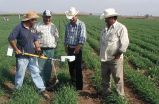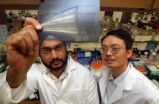(Press-News.org) About 20 years ago, the late Thomas Gold, in his landmark concept paper published in the Proceedings of the National Academy of Sciences of the United States of America, postulated that a "deep, hot biosphere" exists in the crust of the Earth [1]. Gold suggested that this biosphere is as deep as 6 km, and is supported by geological energy sources [2]. The Earth's "deep biosphere", as we know today, should include a variety of subsurface habitats, such as aquifers and sedimentary rocks in the continental regime, and sediments and igneous rock in the marine realm.
The oceanic crust constitutes the most voluminous, continuous aquifer system on the planet, the so-called subsurface ocean. Large areas of volcanic crust are exposed to seawater and serve as the conduits of fluids, heat, solutes, and biological material that are exchanged between the oceans and the lithosphere [4]. Seawater flows through sediments and basalts and actively circulates through faults, fractures, and other permeable conduits in the oceanic crust and underlying mantle. In doing so, it redistributes heat, alters rock, forms secondary mineral deposits, and influences the chemical composition of the oceans and the crust [5]. The rate at which water flows into and out of oceanic crust rivals the flow of all the world's rivers into the oceans. This massive and dynamic plumbing system cycles the entire volume of Earth's ocean water through the subseafloor every 200,000 years [6].
Oceanic crust is a giant microbial incubator, and hosts an extensive microbial population [7]. Current estimates suggest that ½ to 2/3 of the total biomass of the Earth resides in the deep biosphere [3]. Microorganisms are involved in weathering oceanic crust, in the transformation of minerals, in the exchange of elements between the crust and the ocean, and in the deposition of elements in the crust [8, 9]. Micro-scale reactions mediated by seafloor-dwelling microbial communities exert planetary-scale impacts on biogeochemical cycles. However, given the shallow depth of the magma chambers at a mid-ocean ridge (1.6.4 km below the sea floor for the fast-spreading East Pacific Rise and 3.0.4 km for the slower spreading Mid-Atlantic Ridge), the deep subsurface biosphere is probably limited to older and cooler ridge flanks and the upper few hundred meters of permeable volcanic basalts and metal-sulfide deposits over the ridge [10].
A major challenge in exploring the deep biosphere is determining cell abundance and viability, i.e., whether detected cells are viable, dormant or dead. Techniques commonly used for detecting subsurface microorganisms include: (1) microscopic cell counts using non-specific fluorescent DNA (RNA) stains (e.g., acridine orange direct count); (2) DNA sequencing; (3) isolation and cultivation; (4) microbial activity inferred from a radiotracer (e.g., 14CH4); (5) intact phospholipid analysis; and (6) microbial processes inferred from pore water geochemistry. All but the phospholipid technique suffer from the shortcoming that a dormant or dead cell can be detected and as a result, a fraction of the total cells measured can be non-living cells [11]. To this end, the phospholipid technique may hold special hope for estimating viable biomass in the deep subsurface environment. Recently, techniques targeting ribosomal RNA such as catalyzed reporter deposition-fluorescence in situ hybridization showed great promise in detecting viable cells in the deep biosphere. For the first time, Schippers et al. [11] demonstrated the presence of intact microbial membranes and ribosomes in the deep subsurface.
Single-cell genomics are noteworthy because they have opened up a new front in environmental microbiology [12]. Using a method called multiple displacement amplification, a few femtograms (10-15 g) of DNA in a single microbial cell can be amplified to micrograms to be used in sequencing [13]. Thus, single-cell genomics can be extremely useful in exploring the deep biosphere in: (1) characterizing culturable as well as unculturable microorganisms, genotypically and phenotypically (e.g., [14]); (2) guiding the assemblage of metagenomic sequences (which are contributed to by all of the species and by many cells of each individual species in a sample) to reveal microbial diversity, the core genome of species, evolution and gene transfer, and the linkage between genes and ecology (e.g., [15]); and (3) understanding mechanisms of metabolically active and dormant microorganisms of microbial populations in the deep subsurface.
Examinations of the deep subseafloor biosphere hosted in rock hold promise for revealing new and remarkable information about unique and remote life on Earth and the possibilities for life on other planetary bodies. Despite recent advances in this young field, many fundamental questions remain to be answered: What is the phylogenetic and physiological diversity and complexity of the deep biosphere? What are the sources and types of energy, metabolic activity and pathways? What are the physical, chemical, and energetic limits of habitability? What are the spatial dimensions of the dark energy environment and the extent of the deep biosphere? Finally, what are the function and dynamics of the deep biosphere. Scientific drilling (e.g., IODP) will continue to provide a major platform for sampling and exploring the deep biosphere.
###
Jiasong Fang, School of Ocean and Earth Sciences, Tongji University, 1239 Siping Road, Shanghai, China.
Li Zhang, State Key Laboratory of Geological Processes and Mineral Resources, College of Earth Sciences, China University of Geosciences, Wuhan, Hubei, China.
References:
1 Gold T. The deep, hot biosphere. Proc Natl Acad Sci USA, 1992, 89: 6045�
2 Gold T. The Deep Hot Biosphere. New York: Copernicus (imprint of Springer-Verlag), 1999. 243
3 Whitman W B, Coleman D C, Wiebe W J. Prokaryotes: The unseen majority. Proc Natl Acad Sci USA, 1998, 95: 6578-6583
4 Edwards K J. Geomicrobiology in oceanography: Microbe-mineral interactions at and below the seafloor. Trends Microbiol, 2005, 13: 449�
5 Wheat C G, Jannasch H W, Kastner M, et al. Seawater transport and reaction in upper oceanic basaltic basement: chemical data from continuous monitoring of sealed boreholes in a midocean ridge flank environment. Earth Planet Sci Lett, 2003, 216: 549�
6 Johnson H P, Pruis M J. Fluxes of fluid and heat from the oceanic crustal reservoir. Earth Planet Sci Lett, 2003, 216: 565�
7 Teske A P. Microbial communities of seep marine subsurface sediments: molecular and cultivation surveys. Geomicrobiol J, 2006, 23: 357�
8 Bach W, Edwards K J. Iron and sulfide oxidation within the basaltic ocean crust: Implications for chemolithoautotrophic microbial biomass production. Geochim Cosmochim Acta, 2003, 67: 3871�
9 Cowen J P. Fluids from aging ocean crust that support microbial life. Science, 2003, 203: 120�
10 Amend J P, Teske A. Expanding frontiers in deep subsurface microbiology. Palaeogeogr, Palaeoclimatol, Palaeoecol, 2005, 219: 131�
11 Schippers A, Neretin L N, Kallmeyer J, et al. Prokaryotic cells of the deep sub-seafloor biosphere identified as living bacteria. Nature, 2005, 433: 861�
12 Lasken RS, Kvist T, Ishøy T, et al. Multiple Displacement Amplification from single bacterial cells. In: Hughes S, Lasken R, Eds., Whole Genome Amplification. Scion Publishing Ltd., 2005. 119�
13 Lasken R S. Single-cell genomic sequencing using Multiple Displacement Amplification. Curr Opin Microbiol 2007, 10:510�
14 Siegl A, Kamke J, Hochmuth T, et al. Single-cell genomics reveals the lifestyle of Poribacteria, a candidate phylum symbiotically associated with marine sponges. The ISME Journal, 2011, 5:61
15 Woyke T, Tighe D, Mavromatis K, et al. One bacterial cell, one complete genome. PLoS ONE 2010, 5: e10314. doi:10.1371/journal.pone.0010314
Exploring the deep biosphere
2011-06-03
ELSE PRESS RELEASES FROM THIS DATE:
New sound synchronization technology holds the key to earlier diagnosis of heart disease
2011-06-03
Innovative UK technology is contributing to the development of a revolutionary digital stethoscope that could make it easier for GPs to spot the first signs of heart disease.
With Engineering and Physical Sciences Research Council (EPSRC) funding, a Queen Mary, University of London (QMUL) team has developed a computer-based technology that synchronises the various sounds collected by the new stethoscope and which make up a human heartbeat.
The sounds can then be analysed by an existing technique called ICA (independent component analysis), with data presented on a laptop ...
Microscopic worms could help open up travel into deep space
2011-06-03
A space flight by millions of microscopic worms could help us overcome the numerous threats posed to human health by space travel. The Caenorhabditis elegans (C. elegans) have also given experts an insight into how to block muscle degradation in the sick and elderly.
The worms — from The University of Nottingham — were flown into space onboard the Space Shuttle Atlantis. They spent 11 days in orbit onboard the International Space Station more than 200 miles above the earth.
Many of C. elegans' 20,000 genes perform the same functions as those in humans. Experts in human ...
Safer sex: Study examines sexual communication in transgender community
2011-06-03
A new study from North Carolina State University shows that talking about safer sex is a complicated process for individuals in the transgender community. The finding may help efforts to promote safer sex practices in a community facing high HIV rates – and also sheds light on broader questions related to safer sex for everyone.
"The main reason for this study is the fact that we're seeing evidence of devastatingly high HIV prevalence rates in the transgender community," says Dr. Kami Kosenko, an assistant professor of communication at NC State and lead author of the ...
Fraser Yachts Exclusive - Fairer Winds Expected this Summer
2011-06-03
As the Mediterranean prepares for the summer season the yacht brokerage market is looking fairly healthy in contrast to this quarter in recent years. Supporting this resurgence are the annual boat shows that are beginning to see increased interest and enquiries through their continued efforts.
Although all areas of the business are showing equal improvements this cannot be said to be spread across Fraser Yachts' entire network worldwide however with some regions recovering quicker than others it would seem.
Most recently interest appears to be concentrated in the ...
Cognitive impairment seen in preschool children with epilepsy
2011-06-03
A recent study has shown that cognitive impairment is evident early on in preschool children with epilepsy, consistent with results of similar studies in older children. Age of onset of first seizure is a significant predictor of cognitive impairment according to this study—the first to evaluate cognitive impairment in children age three to six. The report is available in Epilepsia, a journal published by Wiley-Blackwell on behalf of the International League Against Epilepsy (ILAE).
Epilepsy is characterized by recurrent seizures that range from mild staring spells to ...
The blame game in work-family conflict
2011-06-03
INDIANAPOLIS – When the demands of work and family conflict, is the job blamed, is the family role blamed or is blame placed on both? And what are the consequences?
A new study by Elizabeth M. Poposki, Ph.D., assistant professor of psychology in the School of Science at Indiana University-Purdue University Indianapolis, is the first to explore day-to-day experiences in attributing this type of blame. The work examines individual incidents of work-family conflict and tracks how blame for this conflict is attributed.
Only three percent of those surveyed blamed both work ...
Farmer networks hold key to agricultural innovation in developing countries, Stanford study finds
2011-06-03
New technologies can improve agricultural sustainability in developing countries, but only with the engagement of local farmers and the social and economic networks they depend on, say Stanford University researchers. Their findings are published in the May 23 online edition of the Proceedings of the National Academy of Sciences (PNAS).
"Most people tend to think that technology information flows to farmers through a direct pipeline from scientists, but that isn't true," said lead author Ellen McCullough, a former research fellow at Stanford's Program on Food Security ...
Cause and potential treatment found for cancer drug's kidney toxicity
2011-06-03
AUGUSTA, Ga. – Scientists may have a way to make the powerful cancer drug cisplatin less toxic to the kidneys and more effective against some cancers.
The chemotherapeutic agent used in combination with other drugs for a variety of cancers, results in kidney damage or failure in about 30 percent of users, although the mechanism has been unclear. The most physicians can do today to protect the kidneys is advise patients to drink more water.
The relatively simple, highly reactive compound tends to accumulate in the kidneys, said Dr. Navjotsingh Pabla, postdoctoral fellow ...
Iron key to brain tumor drug delivery
2011-06-03
Brain cancer therapy may be more effective if the expression of an iron-storing protein is decreased to enhance the action of therapeutic drugs on brain cancer cells, according to Penn State College of Medicine researchers.
Malignant glioblastoma multiforme is a deadly brain tumor for which no long-term effective cure exists. Because drugs in the blood do not pass from the blood vessels to the brain, effective amounts of chemotherapy drugs do not reach the tumor. Increasing dosages damage normal brain tissue and cause significant neurological damage. These dosages also ...
Children eat more vegetables when allowed to choose
2011-06-03
This release is available in French and Spanish.
A gesture as simple as allowing children to freely choose the vegetables they want to eat helps to increase the consumption of these foods in children, as University of Granada has found. Moreover, his work suggests that the bitter taste of calcium, present in vegetables such as spinach, collard greens, cabbage, onions, chard or broccoli, can be a factor negatively influencing children's consumption of vegetables.
To carry out this experimental study, the authors analyzed the main factors determining vegetable consumption ...


